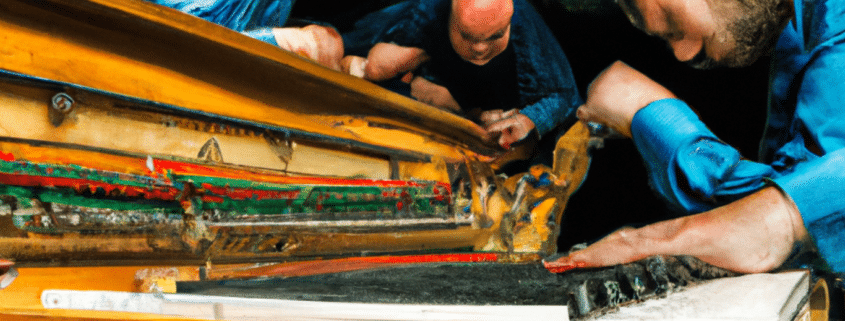The piano: tuning, punching and fine-tuning the mechanics
- Author Profile
- Recent posts
Pianist, Composer, Arranger, Sound Engineer, Writer, Blogger
Alessandro Fois is a musician, composer, pianist, arranger and sound engineer. Since 2018, he has also been a writer, blogger and webmaster. He currently resides in Ivrea (Turin) where, in addition to the above activities, he manages Lycnos, studio for audio, video and web services, and the recording studio Glamour Recording Studio.
Piano Maintenance
The care and maintenance of your piano is crucial to ensure optimal performance over time. In this article, we explore the different aspects of maintenance, from delicate tuning to the subtle arts of tonal calibration of hammers and tuning the mechanics. Find out in short how to preserve and improve the sound of your precious musical instrument.

Piano tuning
The tightness of the tuning of an acoustic piano is greatly influenced by the structure of the instrument, its age, movement, changes in temperature and air humidity, the ability of the tuner, and, of course, the simple stresses resulting from its use.
While theoretically at least one tuning per month would be required to ensure a high level of satisfaction when using the instrument, it is fair to say that a studio piano should be tuned at least once or twice a year.
Furthermore, if it is a piano to be used for concerts or gigs, it should be tuned more often, preferably just before each concert.
A healthy, dry environment and a constant temperature will enable a quality piano to stay well-tuned for longer and will help it to last longer.
Of course, the digital piano will never need any tuning at all, as it is itself determined through the recording of samples taken from perfectly tuned quality pianos.
Tone calibration of the piano by punching hammers
The sound produced by the piano comes from a wooden hammer covered with wool felt that strikes a string or a group of two or three strings tuned in unison. The tonal quality to a large extent also depends on the consistency of the felt impacting the string, i.e. the hardness, elasticity and shape of its impacting surface.
The term 'piano tuning' does not refer to its tuning, but rather to the punching or stretching operations performed on the felt covering the hammers, which regulate the timbral quality of the instrument's attack transients so as to enable it to emit timbrally homogeneous and progressive sounds throughout its extension and at the various dynamic ranges.
Punching, i.e. making small holes in the felt with a special tool in order to soften it, or, on the contrary, stretching it to harden it or sculpting its shape, are all operations that allow the timbre of each individual note to be shaped.
Obviously, the most typical drawback is caused by the hardening of the felt of the hammers after a certain period of use; the felts will tend to compress and groove as a result of the countless impacts on the strings; they will then become much harder, causing the following imbalances:
- The sound will become more aggressive and edgy, as well as less expressive and modulated
- The strings will receive more stress with each impact, which will also greatly affect the tuning tightness in the long run
It will therefore be necessary to periodically punch the felts of each hammer in order to restore their original or ideal softness; the intervals between punching should be shorter the more intense, dynamic and prolonged the use of the instrument.
Fine-tuning the piano mechanics
The mechanics of the piano are composed of numerous parts, some of which have adjusting screws. Fine-tuning the mechanics therefore consists of regularising and optimising the path of the moving parts, according to the structural choices made by the manufacturer and the needs of the pianist; therefore, this can be done either in a standard manner or in the pursuit of relative customisation, since executive control can be improved by appropriate adjustment of the instrument's mechanics
A well-tuned piano means maximum reactivity and thus greater dynamic and expressive control as well as greater playing pleasure.
The recurrence of these operations can vary greatly depending on how long the instrument has been used, the touch and the holding capacity of the instrument, but typically ranges between 1 and 6 years.
The most common indicators of the need for fine-tuning are:
- keys that seem not to go deep enough or go too deep
- sound response showing uneven volume in the various notes with the same pressure intensity
- key tops positioned at different heights instead of perfectly aligned
- difficulty in obtaining and controlling pianissimo and/or fortissimo dynamics
- touch sensation of keys that are too light and others that are too heavy
- difficulty in executing a rapid and homogeneous rebound of the same note
- shacklers that do not block well and others that block too much or too quickly
- hammers that do not return correctly to the rest position or remain misaligned during the escapement function
- other various and unforeseeable inconveniences
Conclusion
In conclusion, the piano is a work of sonic art that requires constant care to maintain its beauty and musicality. From regular tuning to the delicate tonal calibration of the hammers that shape its sonic character, to fine-tuning the mechanics to ensure a precise and responsive touch, every aspect of maintenance is essential to keep the instrument at its full potential.
The frequency of these operations may vary depending on the use of the piano, but investing time and attention in its maintenance will pay off with outstanding performance and a longer lifespan, allowing it to continue to be a source of inspiration for many years to come.
If you would like more information or have questions about the piano, comment on the article.






Leave a Reply
Want to join the discussion?Feel free to contribute!